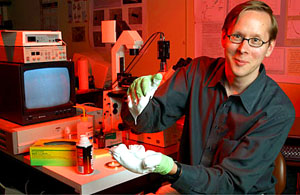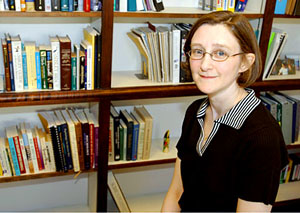|

|
Emory
leads state in sponsored research
Emory
was the top research university in Georgia in external sponsored
research for fiscal year 2004. Of the three major research universities
in the state, Emory brought in $352 million, a 10 percent increase
from last year; Georgia Tech brought in $342 million; and the University
of Georgia brought in $228 million.
"This is actually a fantastic compliment to our faculty,
schools, and units, as well as our post-docs, fellows, and students,"
says Frank Stout, vice president for research. "Emory continues
to make its name and science known within the nation and the world,
which means we’ll continue to be able to attract additional
support."
The Woodruff Health Sciences Center, which includes the schools
of medicine, nursing, public health, and Yerkes National Primate
Research Center, received $328.9 million, or more than 93 percent
of the University’s total external research funding.
|
Increasing
transplant tolerance
The
American Society of Transplantation has awarded Christian P. Larsen,
Carlos and Marguerite Mason Professor of Surgery and director
of the Emory Transplant Center, the 2004 Roche Basic Science Award.
Larsen’s specialty is finding ways to increase the body’s
tolerance of transplanted organs.
Hope
Clinic receives $2.2 million
The
Hope Clinic of the Emory Vaccine Research Center has received
a contract of about $2.2 million from the Centers for Disease
Control and Prevention (CDC) to conduct clinical trials of promising
topical microbicides to prevent HIV.
Vaccine
expert honored by CDC
The
CDC honored Walter A. Orenstein, former director of the National
Immunization Program, with the Charles C. Shepard Lifetime Scientific
Achievement Award. Orenstein is director of Emory’s Program
for Vaccine Policy and Development, and associate director of
the Vaccine Research Center and the Southeastern Center for Emerging
Biologic Threats.
|
|
|
|
|
|
Exploring
the frontiers
of physics in outer space
In
certain physics experiments, gravity can pose quite a problem.
"On
earth, particles are heavier than liquid. Over time, they sink
and become more concentrated," says Associate Professor
of Physics Eric R. Weeks. "The sedimentation effect can
kill you."
Weeks (below) studies colloidal suspensions–microscopic
plastic particles placed within a flowing liquid–as a model
to better understand one of the remaining mysteries of science:
When is the exact moment that a liquid becomes a solid and not
just a slow-moving liquid? This pivotal instant is known as
the "glass transition."
 A
gravity-free environment would provide more favorable conditions
for carrying forward his research, Weeks concluded, so he wrote
a grant proposal to the National Aeronautics and Space Administration.
"NASA has had really good luck with flying experiments
like this on the space shuttle," he says. A
gravity-free environment would provide more favorable conditions
for carrying forward his research, Weeks concluded, so he wrote
a grant proposal to the National Aeronautics and Space Administration.
"NASA has had really good luck with flying experiments
like this on the space shuttle," he says.
Not
only did NASA approve the grant, but on May 4, Weeks and three
other scientists nominated by the agency received the Presidential
Early Career Award for Scientists and Engineers, the highest
honor bestowed by the United States government on outstanding
scientists and engineers early in their careers. Fifty-seven
scientists and engineers were honored in all.
The
NASA nominees were selected from investigators in its science
programs who have proposed "exceptionally meritorious,
innovative research in areas that will benefit NASA’s understanding
of the earth’s systems, the solar system and the universe,
the exploration and development of space, or the development
of advanced astronautics and space technologies."
"We
are thrilled to honor these promising researchers, and we certainly
will look to them to lead the way for NASA’s future scientific
and engineering endeavors," said NASA administrator Sean
O’Keefe.
Weeks,
whose research is more routinely conducted in his earthbound
lab in Cherry Logan Emerson Hall, also studies various "squishy"
substances that exist at the intersection between solid and
liquid, such as hair gel, foam, and salad dressing. These experiments
have attracted media attention–Weeks was on National Public
Radio in January speaking about the texture of food.
His
work has potential applications in everything from beauty products
to heavy machinery.
"Why
don’t the small bubbles drift upward in hair gel?"
Weeks asks. "What causes shaving cream to flow differently
than toothpaste? Why does mayonnaise act both like a liquid
and a solid? How does the texture of butter change when you
take out the fat? How do you make a longer-lasting industrial
lubricant?"
Donning
a pair of 3-D glasses, Weeks examines an image captured by the
lab’s state-of-the-art confocal microscope–an optical
microscope hooked to a laser, which can peer deep inside substances
and provide a three-dimensional movie of their flow.
"We
kind of understand atoms, crystals, why water freezes, chemical
bonds," he says. "But the glass transition, no one
understands. It’s all one very big conjecture right now."–M.J.L.
|
|
SONGBIRD
BRAIN
For
most of us, the sound of birds singing serves as a happy, tranquil
soundtrack to time spent outdoors.
But
for Assistant Professor of Psychology Donna Maney (below), bird
song is one piece of a fascinating neurological puzzle, and
she hopes to gain a deeper understanding of its place among
the various regions of the brain.
 “Songbirds
possess a talent rare among non-human animals: the ability to
learn complex vocalizations,” Maney says. “The system
of brain regions that controls the learning and production of
song has become perhaps the most popular model for studying
the neural basis of a complex learned behavior. Despite this
popularity, few researchers have investigated how the song system
is connected to and affected by brain regions outside it.” “Songbirds
possess a talent rare among non-human animals: the ability to
learn complex vocalizations,” Maney says. “The system
of brain regions that controls the learning and production of
song has become perhaps the most popular model for studying
the neural basis of a complex learned behavior. Despite this
popularity, few researchers have investigated how the song system
is connected to and affected by brain regions outside it.”
While
humans might assume that birds simply sing when they’re
happy or content, the way cats purr, they actually sing only
in very specific social contexts, Maney explains–generally
courtship and territorial behaviors. She means to discover how
the song system interacts with the parts of the brain that influence
social behavior in general, such as motivation and arousal.
“I’ve
always been interested in how the brain works–studying
behavior and neurobiological processes almost feels like a selfish
occupation, because of course I learn a lot about my own brain,”
Maney says. “In college I became very interested in the
evolution of behavior, especially communication. A professor
. . . allowed me to do a small project on songbirds in his lab.
I did a lousy job (I was afraid to touch anything in the lab),
but I fell in love with the research and continued to study
songbirds throughout my graduate and postdoctoral work.”
Maney,
who joined the Emory faculty in 2002, recently received a National
Science Foundation (NSF) Faculty and Career Development Award
of more than $500,000, which will fund her songbird research
for the next five years. These highly sought-after and competitive
awards are given to researchers who not only show tremendous
promise in their fields but also develop innovative techniques
to incorporate into their teaching.
Maney
plans to place special emphasis on writing in her courses, asking
students to write and rewrite papers about their scientific
research and discoveries. Last fall she taught a class on hormones,
brains, and behavior that met the Emory College requirements
for a writing-intensive course; in the spring, she taught a
class in behavioral neuroscience that included the study of
bats, owls, crickets, dolphins, and of course, songbirds.
“My
goal is to engage students as participants in the field of neuroscience,
so I encourage them to write as scientists, for scientists,”
Maney says. “In my writing course, students spend a lot
of time reading journal articles written by scientists and learning
to write in a similar style. Many students arrive with the assumption
that this style of writing is colorless and dry and that their
own creative tendencies will be stifled by it. Over the course
of the semester, however, most students realize how wrong that
assumption is. The best scientists are passionate about their
work, and this comes through in their writing.”
One
of Maney’s students made a remark last year that made her
particularly proud: “A scientific paper can unfold as eloquently
as any piece of fiction.”–P.P.P.
|
|
| |
©
2004 Emory University
|